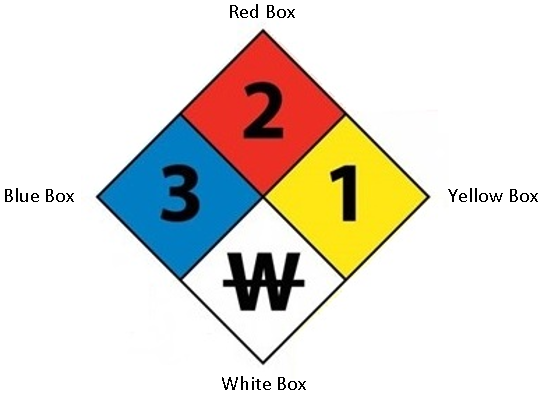WHMIS Quiz
A minimum score of 80% is required before being allowed to stay in lab area for work.
Part A. WHMIS Symbols
Select the correct description about each WHMIS Symbol Below:

Part B. NFPA Diamond
Based on the National Fire Protection Association (NFPA) Diamond below, select the correct description about the relevant Hazardous Materials Classification:

Blue Box
Fire Hazard Level
(Flash Points)
 Symbol
Symbol
 Symbol
Symbol
Part C. True or False
Please select if each of the statement is true or false.
1. One should not eat or drink (includes water) in laboratory space.
2. One should wear appropriate personal protective equipment (at a minimum lab gloves, safety glasses and lab coat) in laboratory space.
3. One is not allowed to wear contact lenses while laboratory work is in progress.
4. No experiment may be left unattended in operation without prior approval.
5. Frolicking/child’s play can lead to serious personal injuries and equipment damage.
6. If one is only looking things over in lab while someone else is doing experimental work in the lab, one is still required to wear personal protective equipment.
7. One is obliged to disclose any current health issues that may jeopardize not only one’s wellbeing but also that of others, and any related future health changes.
8. WHMIS stands for Workplace Hazardous Materials Information System.
9. One should consult Material Safety Data Sheet (MSDS), especially when dealing with materials never dealt with before.
10. Email address related to elerGreen lab is: admin@elergreen.com
11. The usual e-mail issues, such as e-mail capacity and arrival time, have been read and understood.
12. Anyone who is exposed or likely to be exposed to a hazardous material must receive WHMIS training.
13. A Material Safety Data Sheet (MSDS) produced 30 years ago would be out-of-date.
14. A laboratory sample needs to at least be labelled with a product identifier.
15. A compressed gas cylinder should be transported with a regulator attached.
16. An example of a flammable material is gasoline.
17. An example of Biohazardous infectious material is the hepatitis B virus.
18. If Chemical A has an LD50 of 1000 mg/kg while Chemical B has an LD50 of 350 mg/kg, then Chemical B is the more toxic chemical.
19. If Chemical A has a flash point of 35 °C while Chemical B has a flash point of -25 °C, then Chemical B has the greater potential as a fire hazard.
20. Although hazard symbols may be seen in a variety of places, they are only legally required to be present on the supplier label.
Part D. Multiple Choice
Select one option that applies:
1. What is the Company’s No Smoking Policy?
2. Bleach reacts with what compounds to produce dangerous/toxic gases?
3. In the event of an emergency within the lab, what do you do?
4. Your experiment is in progress when the fire alarm rings. It is obvious it does not involve your experiment. What do you do?
5. Why do you suppose contact lenses are not permitted to be worn during the lab, even though you may not be using anything dangerous?
6. Why is it not a good idea to unnecessarily bring bags, backpacks, and wallets to the lab?
7. What are the 3 main ways in which WHMIS provides personnel with information about hazardous materials?
8. What are the main ways in which a hazardous material can enter your body?
9. If a supplier WHMIS label is missing or damaged, it should be promptly replaced with any of the following:
10. I have read and understood the content of the following documents. Copies can be found at various locations at the elerGreen premise, web page or please ask for help.
Score:
| Section |
Score |
Out of |
| Part A. WHMIS Symbols |
|
9 |
| Part B. NFPA Diamond |
|
11 |
| Part C. True of False |
|
20 |
| Part D. Multiple Choice |
|
10 |
| Total |
|
50 |
A minimum score of 80% (40 out of 50 total) is required to pass.